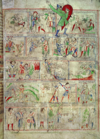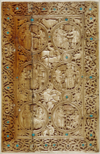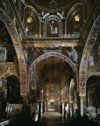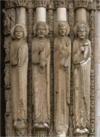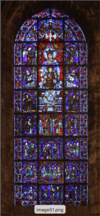Midterm Flashcards
(49 cards)

The Gero Crucifix
970
Cologne, Germany
Patron: Archbishop Gero
- carved in oak
- first monumental sculpture of crucified Christ
- life size, one of the largest of its time; earliest, finest of German wood sculpted crucifixitions
- shape of the Gero Cross -> traditional to Carolingian religious art
- While strong emphasis on the “suffering” of Jesus Christ’s cruxifixtion: slumped head, twisted body, and closed eyes; idealized
- influence on later crosses: rounded, natural style
- Byzantine influence -> marriage of Otto II & Byzantine princess Theophano -> catholic church and Byzantine empire

Reliquary statue of St. Faith
late 9th century
Conques, France
- Wooden core with gold and semi-precious stones
- Reliquary -> container holding the remains of Saint Foy
- Saint Foy:
- a young Christian convert, living in Roman-occupied France during 2nd century
- martyr (someone who dies for their faith): refusal to sacrifice to pagan gods
- relic important to the church -> pilgrims and wealth to Conques (small, isolated town)
- Spolia -> reuse of older matrials in new forms of art; her face staring boldly -> originally, a Roman statue of a child -> not only practical, but also association with the past riches of the Roman Empire
- representational of Romanesque art -> medieval faith, pilgrims

Doors of Bishop Bernward
St. Michael’s, Hidesheim (Germany)
Bronze
1015
Patron: Bishop Bernward
- Bishop Bernward pilgrimage to Rome -> recreate monumental art he saw -> munumental wooden doors at Santa Sabina illustrating scenes from the Old and New Testament
- Left ( Old Testament, Book of Genesis) : temptation, then the expulsion; Right (New Testament, Gospels) : Christ presented to either Herod or Pilate, then cruxifxion
- Visual and Thematic patterns: cruciform shaped tree; Adam & Eve vs. tomentors; trees vs. Mary & John ==> composition, thematic connection of “in Adam all men die, and in Christ all men are made alive” —-> important idea: Christ as new Adam and Mary as new Eve
- Ottonian art -> inheritence of Carolingian Renaissance: ancient lost wax method, doors cast in two single pieces

Marriage contract of Otto II and Theophano
Parchment/vellum
Made in Ottonian Empire
972
- Diplomatic document Ottnian emperor Otto II, Byzantine empress Theophano -> Holy Roman Empire
- Prepared by Otto II as a representation of political and cultural contact b/w Holy Roman Empire and the Byzantine Empire; outlines the extensive profits Theophanu will get
- Marriage act as a recognition of the Ottonian Empire by the Byzantine Empire
- an example of Ottonian Renaissance art; illuminated manuscript on purple(royal color) parchment.

Christ crowns Otto II and Theophano
probably made within the Ottonian Empire
ivory
982/983
- Christ confering divine benediction upon Otto II and Theophano while both in Imperial costume
- Hand on each rulers cowned head: a) blessing or b) coronation
- possible function: to adorn the cover of a royal psalter (a belonging to Theophano)
- precense of the donor figure
- political purposes

Great Mosque of Córdoba
960
Patron: Caliph Al-Hakam II
- view looking towards the mihrab: dazzling color combinition forming complex calligrapic bands
- Temple to the Roman god -> Church by Visigoths -> mosque by descendants of the exiled Umayyads: the first Islamic dynasty, capital Damascus
- After overthow by Abbasids, recreate Cordoba as the new capital, Al-Hakam II is the second Caliph of Cordoba
- an exemple of Muslim world’s ability to rebuilt pre-existing buildings with regional traditions -> central to the forming of Islamic style

Pyxis of al-Mughira
Ivory
made in Córdoba, Spain
968
- Pyxis: a cylindrical box used for cosmetics
- a gift given by a Caliph to his son al-Mughira
- among the best surviving examples of the royal ivory carving tradition in Islamic Spain; containing an inscription and figurative work which -> understanding ivory carving tradtions and islamic art in Al-Andalus (islamic spain)
- Ivory: durable, smooth, elegant, and easily carved -> desired material in Byzantine Empire
- decorated with four eight-lobed medallions surrounded by figures and animals with each medaliion presenting different iconography relating to the pursuits and beliefs of the Umayyads.
https: //www.khanacademy.org/humanities/ap-art-history/early-europe-and-colonial-americas/ap-art-islamic-world-medieval/a/pyxis-of-al-mughira

Cross of Fernando and Sancha
ivory
made in León (Spain)
1063
Patrons: King Fernando and Queen Sancha
- One of the ealiest known crucifix from Spain depicting the body of Christ
- “a cross of ivory with the image of our crucified Redeemer”
- Jey eyes were common at the time in ivory sculptures of the region
- the small space behind the body -> the piece serve as reliquary as typical
- inscription: “Jesus of Nazareth, the King of the Jews”
- below: a digure of Adam
- below: inscription indicating patronage
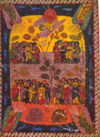
Morgan Beatus
Parchment/vellum
Made in Léon (Spain)
940–945
- Illuminated manuscripts with miniatures by the artist Magius of the Commentary on the Book of the Apocalypse by Spanish monk Beatus which describes the end of days and the Last Judgment.
- the oldest example of a revived Spanish apocalypse tradition
- fine-quality parchment, thick and uniform in color (vibrant)
- Did not use the traditional system Catchwaords (Arabic) to put quires in order, instead Roman numerals followed by the letter “Q” -> bookmarkers are not local or Mozarab vocations to the monastery scriptorium.

New Minster Charter
Manuscript/parchment
made in Winchester, England
966
Patron: Bishop Aethelwold
- New minister: a royal Benedictine abbey in Winchester
- Alfred the Great bought the land whereas his son Edward the Elder, finished the project with the help of Saint Grimbald; body of both were transfered to the New Minister making it an important pilgrimage centre.
- a page from a 966 charter of King Edgar of England in which he confirms the conversion of New Minister into a Benedictine monastery.
- Edgar is pictured here standing between the Virgin Mary and St.Peter
- Charter written entirely in gold -> unprecedent; importance highlightend by the large full-page miniature of the King at the begining of the book: Christ sit above on a rainbow of glory; Edgar holding the charter directly under Christ signifying Edgar’s loyalty to his faith as well as his power is of a divine benediction.

New Minster Liber Vitae
Manuscript/parchment
made in Winchester, England
1020
Patrons: King Cnut and Queen Emma
- King Cnut and Queen Emma presenting a cross to the altar of New Minster
- not just a record of royal donation, but more of a illustratiion of Cnut and Emma ocuppying a place of spiritual realm
- risen Christ is the central figure; earthy hieracy also depicted -> below are the monks New Minster, central monk persumably holding the book of life (Liber vitae) including a list of monks of the community inscribed into the pages of the heavenly

Bayeux Tapestry
wool embroidery on linen cloth
Bayeux, France.
1070
Patron: Odo of Bayeux
- called “Bayeux Embroidery” among art historians; final and best known work of Anglo-Saxon art
- dicpiction of the events leading up to the Norman conquest of England
- The embroidery illustrated the narrative of the events that took place before, during and after the Battle of Hastings.
- The Bayeux Embroidery represents the synthesis of the victorious workers [male narrative] and female craftsmanship [illustrated the point of contact between cultures in visual exchange in which resulted in production of something new, how the meeting of two cultures can produced a visual experimentation – neither French or England work, embodiment of stylization and regionalism, Normans = known for utilizing indigenous traditions to suit their own agenda]

St Vincente
Cardona
Ca. 1120–1140.
- Along the nave, three transverse arches, which are evenly spaced, add support.
- The church was built as a showpiece, and is impressive for its scale—with a height of more than 19 m (62 ft). Its building material is cut stone, and the stonework is both austere and sophisticated, given the uniform size of the cut blocks and the quality of the masonry.

Cathedral of Santiago de Compostela
Santiago de Compostela, Spain
begun 1078
- The cathedral is the reputed burial place of Saint James the Great, one of the apostles of Jesus Christ. The cathedral has historically been a place of pilgrimage on the Way of St. James since the Early Middle Ages, and marks the traditional end of the pilgrimage route.
- The building is a Romanesque structure, with later Gothic and Baroque additions.

Church of Saint-Sernin (St. Saturninus)
1080-1120
Toulouse, France
- Saint Sernin – early Christian martyr and first bishop of Toulouse
- Big and well-located church within the city – built to accommodate those who come on a pilgrimage
- Similar to Santiago but one major – double aisle, maximum flow of people, more space to visitors

Miègeville portal
Marble
Basilica of Saint-Sernin, Toulouse (France)
1110-1115
Portal – main surface for decoration in Romanesque architecture
- Contained lintel and rounded arches, above it is a tympanum
- Transitional area – symbolic element, ornaments became decorative focus of Medieval Architecture
- Can announce and prepare viewer of the space that they are about to enter
- Center – Ascending Christ to heaven, being resurrected – foreshadow of the Second Coming [Last Judgement]
- Angels with Christ, 12 apostles below with 2 old testament prophets [prophesize the Second Coming] at the end – all figures below are looking up at Christ ascending
- Represent pilgrims, creating a closer relationship to Christ [would join the rank of apostles by entering the church – has access to sacred narrative of God, prepare pilgrims to see something special inside the church]
- Crystalized status of church as a sacred space –portal as a transition to a sacred space from a secular world
- Made from 5 marble slabs, distinct stones – carved separately and assembled together [lintel made from 3 slabs of marble] = spolia of late antiquity [before Christianity], reused of marble tombs to make the portal
and contributed to stiff composition
- How does the use of spolia contribute to this piece?
- Fits the narrative of Christ’s ascension [literally rising from the tomb, resurrection]
- Use of spolia materialized sacred narrative
- Emphasized theme of death of the cathedral
- Placed lintel as early Christian marble [material of late antiquity - marked triumph of Christianity over Pagan Rome and legitimization of roman Christianity in 11th century France] – historical argument being made within the tympanum

Church of Ste. Foy
Conques, France
1050–1110
- Included in the route to Santiago – a location stop within the pilgrimage map
- Ste. Foy – known for the beautifying of her vessel, the amount of golds and jewels is evidence that pilgrimage is a source of wealth [a pilgrim would leave a donation to their saints – money used by monks of the church]

Last Judgment Tympanum
Church of Ste. Foy, Conques, France
1110
- Once painted with bright colors for the details to prominent to the viewers
- Eschatology in action - an illustration of events of the Last Judgement [Left – Heaven, Louis the Pious, present because he founded the church and Right – Hell, surrounded by sinners with guard angels to keep devils out]
- At the bottom – vertical separation, a confrontation between good and evil [angels and demons, weighting souls of the death – conversation between good and evil]
- Within the depiction of hell – Satan, seated in the center, with sinners Adam, Eve and Judas – represented familiar iconography for viewers, invoke audience’s emotional response
- Heaven – peaceful and orderly, illustrated the instruction to go to Heaven [Ste. Foy and Christ, reaching to touch her – presented within the tympanum, exact same throne – represented her direct access to Christ, privilege few with access]
- Faith, does not look at a person, but like her expensive relic and vessel – invoke a sense of righteousness of the pilgrims, contributing to future salvation of self [reminded the viewers of the authenticity of Faith’s role as a saint, illustrated the final goal of pilgrimage – Faith will speak to Christ on your behalf, an investment in your salvation (more saints on pilgrimage journey will speak for your salvation)]
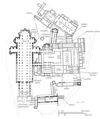
Plan of Cluny III
1088–1130
Cluny, France
Rebuilt under Abbot Hugh
Over the course of the 10th, 11th and 12th century, Cluny built a monastic empire in Western Europe – established a network known as daughter house
- Monasteries who followed the Benedictine rule as Cluny did and only answer to the main house, in turn, only answer to the Pope
- Influence spread all over Western Europe – daughter house with the house shared key exemption from local power structures
- Grew in power, wealth and population – During the late 11th century, Cluny’s Abbot, Abbot Hugh, had the building rebuilt [Cluny III]
- Massive – Abbot wanted to outdo the Pope himself [Cluny III – Larger than Old Saint Peter, largest church in Western Christendom]
- Contain 2 Transept with galilee [emphasis on liturgy – the public performance of Christian rituals in church as well as the cloister]
- The addition of an extra transept with radiating chapels meant more altars in which maximizes and creates more spaces for liturgy and rituals could be celebrated at once
- The elaboration of liturgy goes hand in hand with the elaboration of the architecture

Cluny III abbey church
begun in 1088
Consecrated 1095
Patron: Abbot Hugh
- most influential monastery in Western Europe [wrecked during the French Revolution]
- monastery: An isolated place where religious men and women could live together in a community [men and women are separate – monks and nuns] – a place where they can focus on work, prayers and study
- Meant to self-sufficient buildings [multiple functions within the building, including scriptorium where monks made manuscripts, written and illustrated, from vellum – calf’s skin, thin leather]
- Lives of monks and nuns, organized by a set of rules written by St. Benedict in the 6th century – basis for European monasticism
- Monks who established the Cluny in the early 10th century, were Benedictine – initially wanted to reform the Benedictine monasticism – to ensure that all monks abide by this rule uniformly
- In the year 909, when the land was granted to the monk, owner waived all rights as land owners – questionable only Rome and Pope, gave great freedom for the monks [religious and financial freedom – more independent = more potential for growth]

Mission of the Apostles
Fresco
Berzé-la-Ville, France
1109
Patron: Abbot Hugh
- Private chapel of Abbott Hugh [located 7 miles away from Cluny III]
- Believed that artist who worked on Cluny III fresco also worked on Abbott Hugh’s private chapel
- *Christ in an almond-shaped mandorla, surrounded by 2 apostles, handing out the scroll to St. Peter – this composition is called the Mission of the Apostles
- Based on an episode in the testament where Christ tells his disciples to tell the world about him [the conversion and spreading of Christianity]
- A reminder of monastic mission [directly came from Christ himself] of monks – monks viewed as apostles to Christ
- This imagery is an acknowledgement of the authority of Peter and Rome over all other religious institutions - also asserts the relationship between Cluny III and the Pope, remind the audience of the close relationship between the two institutions

Monte Cassino
Consecrated 1071, Southern Italy
Rebuilt under: Abbot Desiderius
- The site of Monte Cassino was founded by Saint Benedict himself – the main source and symbolic origin of Western monasticism
- Rebuilt during late 11th century by Abbott Desiderius – later become Pope in Rome
- Destroyed during WWII by the Allies – evidence suggested that it was heavily decorated with Byzantine mosaics – what Byzantine artists were known for
- Plan inspired by old Christian buildings – Old St. Peter’s
- Monte Cassino – deliberate copy of old Christian architecture, revived of architectural characteristics of Constantine’s patronage – political statement about its own political and historical roots in Rome

View of apse, Sant’Angelo in Formis
1072-1100
Southern Italy.
rebuilt under Abbot Desiderius
A) Nave arcade, made with delicate marble columns – _precious and expensive materia_l, also used in Old St.Peter’s church [strong associated with Rome and Late Antiquity]
- Emulated architecture of Old St. Peter’s – the main authority in Rome
- Representation of how a building can refer to multiple buildings and authorities
B) Christ in Majesty and angels, from the apse frescoes of San’t Angelo in Formis
- Christ in the center, surrounded by 4 creatures, holds open a book and sign of blessing with righ; hand – imagery of Christ’s judgement
- Abbott Desiderius of Monte Cassino, presenting the church to Christ – how the patronage of buildings was seen as an offering to Christ as a way to find pleasure and salvation – rebuilt buildings because it is an investment of his salvation
- Similar to Mission of the Apostles – stylistically similar, though both has different composition and subject matter [also painted by Byzantine artist like Monte Cassino and their daughter houses]
- Demonstrated the connection of Cluny and Monte Cassino/Rome – reference to Monte Cassino is a reference to Rome itself [reminder of that Cluny is under the authority of Rome and their close relationship - distinct characteristics of Cluny, actualized that Rome was the source of political and spiritual authority for Cluny]
- Demonstrated Byzantine’s importance on Rome’s artistic and political value [Otto II + Theophano vs Mission of the Apostles]

Abbot Desiderius offers his church to Christ
Apse fresco
Sant’Angelo in Formis, Italy
ca. 1072-1100
Abbott Desiderius of Monte Cassino, presenting the church to Christ – how the patronage of buildings was seen as an offering to Christ as a way to find pleasure and salvation – rebuilt buildings because it is an investment of his salvation










